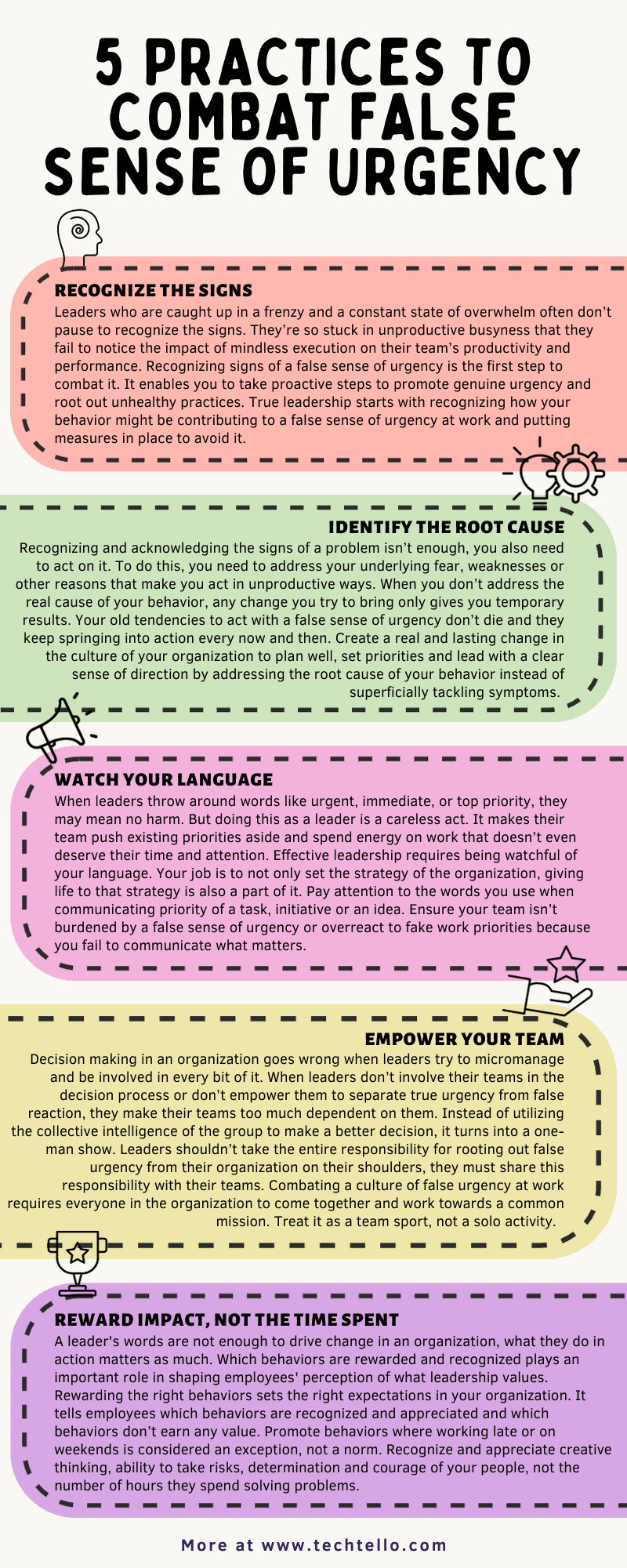How to Combat a Culture of False Urgency at Work

Some leaders ruthlessly prioritize to ensure important work is not compromised at the cost of urgent actions. Other leaders treat every request as a priority and don’t pay attention to how much something deserves their attention.
Attaching a heightened sense of urgency to every request makes it difficult for their teams to get any meaningful work done. Being bombarded with a false sense of urgency makes them operate like a mad powerhouse—people in the team keep running in many different directions without actually reaching anywhere.
Jumping from one task to another and being in a constant state of overwhelm and reactivity can drain team energy, increase stress and can even lead to burnout. When employees don’t get time to do deep work or experience the joy and pleasure of being in a state of flow, they feel unhappy, stuck and dissatisfied.
Mindless busyness due to a false sense of urgency does not lead to progress, it only adds to stress.
Expecting your team to take urgent requests seriously and attend to them in a timely manner isn’t wrong. It’s counterproductive when every other request is given a high priority and the team is expected to jump at the chance.
It’s your responsibility as a leader to build the right culture in your organization—one where impact, creative thinking and long-term value creation is valued over unwanted chaos, firefighting and reactive thinking.
If leaders don’t articulate their priorities clearly, then the people around them don’t know what their own priorities should be. Time and energy and capital get wasted.
— Robert Iger, The Ride of a Lifetime
Here are the five practices that can turn your leadership style from ever-present panic, anxiety or fear to intentionality in thinking and calmness in body language.
Recognize the signs
Leaders who are caught up in a frenzy and a constant state of overwhelm often don’t pause to recognize the signs. They’re so stuck in unproductive busyness that they fail to notice the impact of mindless execution on their team’s productivity and performance.
Recognizing signs of a false sense of urgency is the first step to combat it. It enables you to take proactive steps to promote genuine urgency and root out unhealthy practices.
Here are some signs of urgency culture:
- Employees are expected to be available on demand all the time.
- Your team is constantly in a panic and fire fighting mode.
- Ad hoc requests keep eating into your team’s bandwidth as every request shows up as top priority.
- Your team has no clarity on what qualifies as a valid request and what doesn’t demand their time and energy.
- Being busy is equated with high performance without consideration for value creation and productivity.
Organizations are often spread too thinly across too many priorities, and too many of them are ill defined. Things tend to get added to the pile over time, and before we know it, we have huge backlogs. We’re spread a mile wide and an inch deep. The problems with pace and tempo are, of course, related to having too much going on at the same time. It feels like swimming in glue, moving like molasses.
— Frank Slootman, Amp It Up
True leadership starts with recognizing how your behavior might be contributing to a false sense of urgency at work and putting measures in place to avoid it.
Identify the root cause
Recognizing and acknowledging the signs of a problem isn’t enough, you also need to act on it.
To do this, you need to address your underlying fear, weaknesses or other reasons that make you act in unproductive ways. When you don’t address the real cause of your behavior, any change you try to bring only gives you temporary results. Your old tendencies to act with a false sense of urgency don’t die and they keep springing into action every now and then.
Your unpredictable behavior not only confuses your team, acting rationally one moment and irrationally the next makes you lose trust and respect.
Think about what makes you reactive, hyper and act with a false sense of urgency:
- What fear might be causing you to behave this way?
- What gaps in planning might lead to reactivity?
- What beliefs or expectations might be getting in the way of your ability to think clearly?
- What challenges do you foresee with prioritizing work and providing better clarity to your team?
Solving a problem without solving its root cause is like taking a step forward and then one back. Many enjoy the dance, but then complain it doesn’t bring them anywhere.
— Luca Dellanna, 100 Truths You Will Learn Too Late
Create a real and lasting change in the culture of your organization to plan well, set priorities and lead with a clear sense of direction by addressing the root cause of your behavior instead of superficially tackling symptoms.
Watch your language
Leaders have a compelling aura around them—everything they say is taken more seriously, everything they do carries weight.
When leaders want something done, showing a certain sense of urgency is a great way to get things done. But sometimes they misuse this power and authority by dumping everything at their team with a high sense of urgency and expecting them to attend to it with enthusiasm and rigor.
When leaders throw around words like urgent, immediate, or top priority, they may mean no harm. But doing this as a leader is a careless act. It makes their team push existing priorities aside and spend energy on work that doesn’t even deserve their time and attention.
Effective leadership requires being watchful of your language. Your job is to not only set the strategy of the organization, giving life to that strategy is also a part of it. Your language—how you interact with your team, what you convey, how you provide clarity, set priorities and communicate urgency—plays a big role in shaping the outcomes your team achieves.
Communication is your ticket to success, if you pay attention and learn to do it effectively.
— Theo Gold
Leadership is language. Pay attention to the words you use when communicating priority of a task, initiative or an idea. Ensure your team isn’t burdened by a false sense of urgency or overreact to fake work priorities because you fail to communicate what matters.
Empower your team to separate between critical deadlines and other work priorities
Decision making in an organization goes wrong when leaders try to micromanage and be involved in every bit of it. Under the umbrella of a big decision, often many tiny decisions need to be made. It’s these small daily decisions that determine whether your employees are engaged in doing impactful work or unproductive busyness.
When leaders don’t involve their teams in the decision process or don’t empower them to separate true urgency from false reaction, they make their teams too much dependent on them. Instead of utilizing the collective intelligence of the group to make a better decision, it turns into a one-man show.
Leaders shouldn’t take the entire responsibility for rooting out false urgency from their organization on their shoulders, they must share this responsibility with their teams.
To do this, they must:
- Clearly define what constitutes an urgent task and what does not.
- Work with the team on a playbook to handle urgent tasks. This comes in handy when the team is under stress to perform at their best.
- Setup response time expectations for other requests—when will a certain project, task or initiative be delivered, what will be email response time, how will customer complaints or other bugs be handled.
- Empower their team to say no to ad hoc meetings and discussions that are disguised as urgent, but are actually time wasting activities.
Leaders are not responsible for the results, leaders are responsible for the people who are responsible for the results. And the best way to drive performance in an organization is to create an environment in which information can flow freely, mistakes can be highlighted and help can be offered and received.
— Simon Sinek, The Infinite Game
Combating a culture of false urgency at work requires everyone in the organization to come together and work towards a common mission. Treat it as a team sport, not a solo activity.
Reward impact, not the time spent
A leader’s words are not enough to drive change in an organization, what they do in action matters as much.
Which behaviors are rewarded and recognized plays an important role in shaping employees’ perception of what leadership values.
Are people rewarded for solving mistakes after they have happened or for preventing them from happening in the first place?
Are people applauded for staying back late and putting out fires or for the impact they created?
Are people encouraged to make decisions aligned with long-term thinking or are they made to apply short-term tactics from one problem to another?
Rewarding the right behaviors sets the right expectations in your organization. It tells employees which behaviors are recognized and appreciated and which behaviors don’t earn any value.
As a leader, you get what you tolerate. People do not repeat behavior unless it is rewarded.
— Susan Scott, Fierce Conversations
Promote behaviors where working late or on weekends is considered an exception, not a norm. Recognize and appreciate creative thinking, ability to take risks, determination and courage of your people, not the number of hours they spend solving problems.
Summary
- False urgency culture in an organization misleads employees by keeping them super busy, stressed and anxious without doing impactful work or creating any value.
- While everyone around you can notice your tendency to label everything a high priority, you may fail to realize it. Constantly being in a firefighting mode prevents you from seeing the damaging effect of your behavior on your team and organization’s growth. To combat false urgency, stop rushing, pause and recognize the signs.
- Knowing that you don’t prioritize well gives you an opportunity to make corrections. However, you can’t make a long-lasting change in your behavior without understanding your fears, weaknesses or other factors that contribute to it. Dig deeper into the root cause, stop tackling symptoms.
- A leader’s words carry weight—everything they say and do is taken more seriously. You can’t say something is urgent and not expect your team to drop everything else and attend to it. Be careful of how you communicate. Don’t say something is urgent unless you really mean it.
- A leader is responsible for rooting out false urgency from their organization, but they can’t do it without their teams. They can’t make all the decisions, be around all the time or be present everywhere. By empowering your team to make the right decisions and speak up when things aren’t prioritized well, you can collectively achieve the desired outcomes.
- Rewards and recognition are powerful motivators to drive behavior change in your organization. Use them to your advantage by promoting healthy work practices and abolishing unhealthy behaviors.






























